How to Stop a Dog From Jumping Up: Best Tips
- Anja Boecker
- Updated: 2023-08-25
Your furry nose is happy to see you and others, and shows it by jumping happily? Sometimes stormy greetings aren't for everyone. Don't worry, you and your furry friend can learn to channel this energy in a positive way. We'll tell you exactly how to do that in this article.
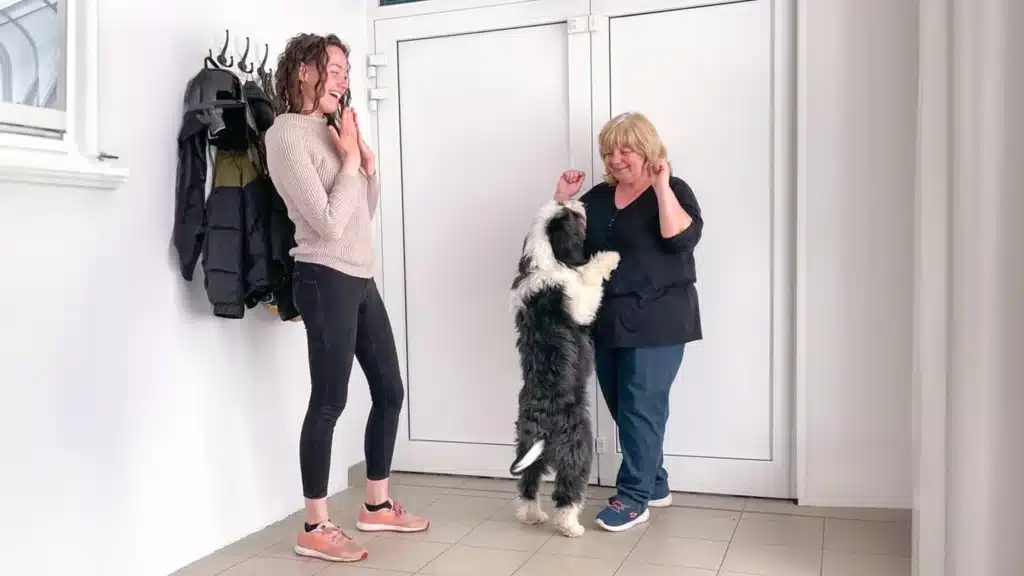
Why Your Dog Jumps on You
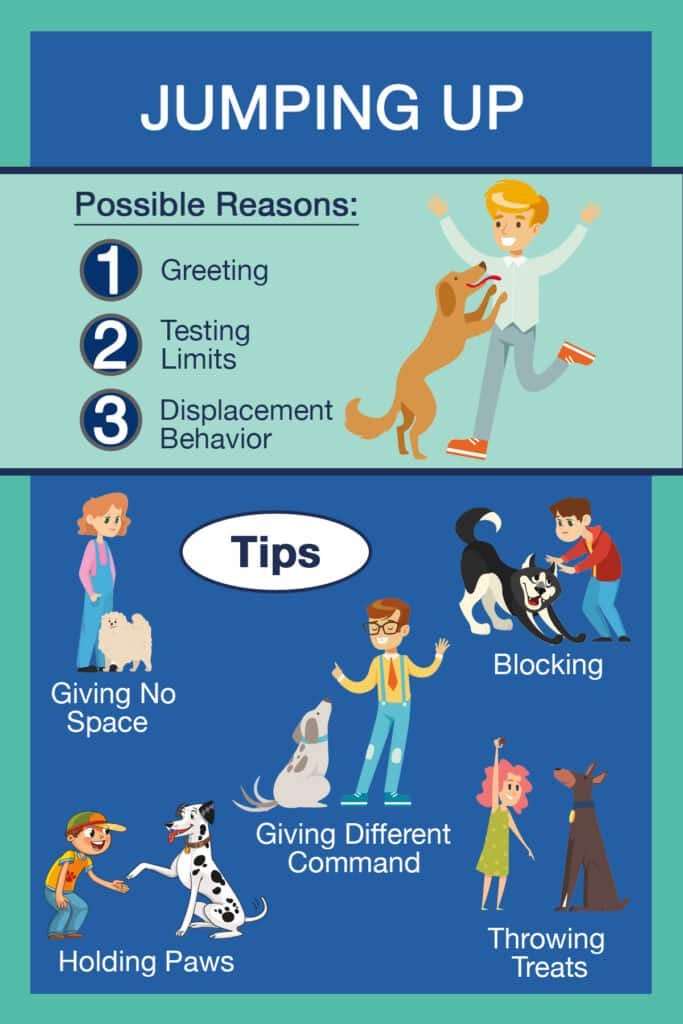
1) Greeting Others
This behavior can be observed in puppies: The puppies jump up to their mother and lick her lips.
She then regurgitates food for her pups. This later becomes a greeting ritual among dogs: Adult dogs greet each other with this gesture.
They would like to greet us humans in the same way. But our faces are too far away. That's why your favorite jumps up to reach the corners of your mouth.
Many dogs are social and enjoy company. A typical reaction to this is to jump on you. It is also a sign of joy and enthusiasm, your dog is excited and happy.
2) Test Their Limits
Sometimes jumping can also be a sign of dominance or insecurity. Your dog may be testing his limits or trying to show control.
Young dogs, and especially stubborn ones, are constantly testing their limits. Failure to return a toy, pulling the human on the leash in the desired direction, and unsolicited roughhousing, including jumping, are some of these typical behaviors.
Many dogs test their humans to see if they can get under their noses. This type of boundary crossing is self-rewarding behavior on the part of the dog:
The more he provokes the scuffle, the more attention he gets - he perceives the pushback when he jumps at him as an interaction and an invitation to provoke further.
3. Nervousness or Skipping
Jumping in a dog is a little like when we humans get nervous and start tapping our fingers or playing with our hair. It simply shows that your dog is unsure or stressed at that moment.
Imagine your dog is in a situation that makes him confused or nervous. Maybe he's been given two commands at the same time and doesn't know which to do first.
At such a moment, your dog may start scratching, sniffing, or even grooming, even though he is not itching or dirty. This is a jumping action.
These are short-circuited reactions of dogs in a state of enormous stress from which they cannot free themselves and therefore perform a seemingly senseless action.
Caused by a conflict situation in the instinctive behavior, the dog performs a behavior that comes from a functional circuit that is not appropriate to the situation.
Jumping as an action can be recognized by an extremely high energy level: The dog will jump up and down frantically, possibly yelping and clinging.
This is a sign that he cannot cope with a new situation (visitor comes and "disturbs" the previous harmony) and begins to jump out of excessive demand.
When a dog is confused or uncertain about a situation, he may try to channel his feelings by jumping. It's as if he's saying, "I don't know what to do, so I'll do whatever comes to mind!"
4. Seeking Attention
Puppies often jump on their mother to get her attention, whether it be for shelter, food, or simply to show social interaction.
Maybe your dog just wants your attention and jumping on him has worked in the past.
Dogs quickly learn that they can attract human attention through certain behaviors.
If the dog realizes that he is getting attention by jumping on him (even if it is just a "no" or pushing his hand away), he may repeat the behavior.
Previous rewards for the behavior: If jumping has been rewarded before, even just with attention, the dog may repeat the behavior in hopes of being rewarded again.
5. Game
Jumping is also a typical play behavior among puppies. They use this behavior to interact with each other, train their motor skills, and strengthen their social bonds.
Although barking may be instinctive, it is important to set clear boundaries early on. Behavior that seems harmless when the puppy is young can become problematic as the puppy grows older.
An adult dog that jumps on people can cause unintentional injury, depending on its size and strength.
This does not mean that you should be harsh or strict with your puppy. Positive reinforcement, or rewarding desired behavior, is often the most effective way to teach a puppy what is and is not acceptable.
→ As puppies, dogs often jump while playing. If this play instinct is not corrected, it can continue into adulthood.
How to Stop Puppies From Jumping Up
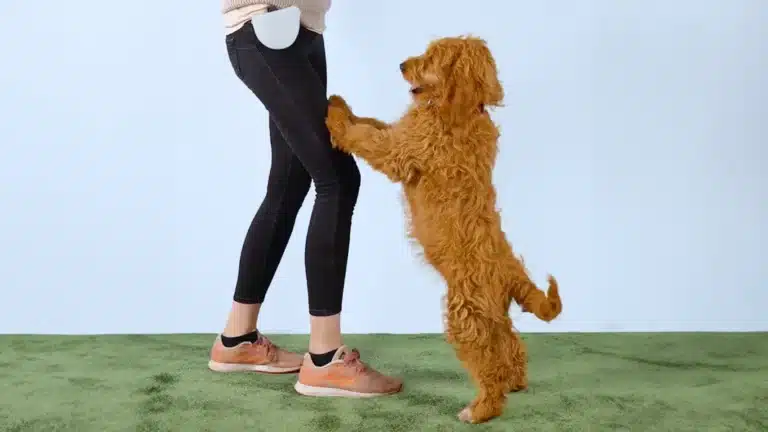
There's nothing wrong with your puppy being happy to see you. But there are other ways.
Although jumping on people is often considered cute in the puppy stage, it is important to teach the puppy early on that this behavior is not desirable toward people. Especially considering how big he will be as an adult dog.
It is always easier to teach good behavior to a puppy than to correct undesirable behavior later in an older dog. It is best to start training as early as possible.
As a puppy, you will quickly teach him other ways to greet you. You should do this as follows:
- Do not react to your puppy's positive or negative jumps.
- Do not look at or pay attention to your puppy.
- Turn away from your puppy or take a few steps back.
That way he knows his behavior will not be rewarded. If you ignore him, he will try to get your attention in other ways.
Do not greet your puppy until he is standing with all four paws on the ground. When he sits or lies quietly in front of you, give him a treat.
Your dog jumps right back at you? Take a few steps away, not back. Backing away can be perceived as pulling by your dog. Ignore him again.
When he is firmly back on the ground, he has your attention again. Puppies learn quickly. Your dog will quickly figure out how to behave to get your attention.
How to Stop a Dog From Jumping Up
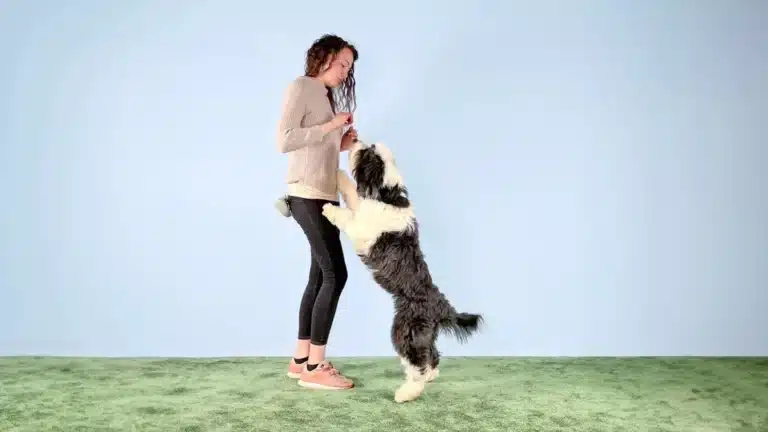
Maybe you've adopted an older dog from the shelter who enthusiastically jumps out to greet you. Don't worry, even the behavior of older pets can be controlled.
With an adult dog, it may just take a little longer to break the old habits.
1) Ignore Their Jumping
Start by doing what you would with a puppy: ignore unwanted behavior and reward your pet for keeping his paws on the ground. This can be done through petting, play, praise, or a treat.
Ignoring older dogs, however, often doesn't work. Many of them enjoy jumping up and down on you. For some pooches, this is more of a game.
→ Then you need alternatives.
2) Cut Off Their Jump
Don't give your dog more space by leaning back or putting your hands in the air. This will prevent him from learning to "push" you away.
If your dog is already in the air, take a stable stance and block the jump with your arm to the side of your body, pushing the dog back.
3) Issue Commands
Another way to stop jumping is to give the dog a command and praise him when he does it.
Say your dog comes up to you and looks like he wants to jump on you. Say "sit" or "down" in a firm voice.
Praise your dog when he sits or lies down in front of you. As a reward, you can squat down next to your dog and pet him. A treat is a positive reinforcement. This is a great way to practice having your pet greet you while sitting or lying down.
If you have already practiced an abort signal such as "No," you can use that as well.
4) Give Your Dog Some Treats
Throw a few pieces of food on the floor each time you greet your dog so that when you arrive, he is busy searching and takes a few seconds to turn back to you. During this time, he will expend much of his excess energy.
5) Greet Your Puppy While Crouching
Consistently greet your dog in a squatting position after the stop signal or distraction is securely in place. Do not give him the opportunity to look up.
If he comes right in your face, turn away again, let him calm down using the above methods, and turn back to him.
6) Use Distractions
Or greet your four-legged friend with a game of fetch.
Don't get involved in your dog's attempt to jump on you. Instead, throw a ball away from you, send your dog after it, and let him bring it back.
When he does, praise him or give him a treat. After a short time, your dog will associate the greeting with a ball game.
But you always need a welcome toy. It's best to place a ball or other interesting toy on a shelf just outside the front door.
7) Catch Their Paws
It is not always possible to react in time to their "friendly" jumps.
If your furry friend has already put her paws on your chest or legs, hold her tight.
Most dogs don't like this at all. Take a few steps back with your dog. Once your pet has had this unpleasant experience several times, he will avoid jumping on his own.
8) Leave Your Dog Alone
Is your dog still jumping on you and engaging in this behavior?
Then there is another option: take him into a room without saying a word and leave him alone for two minutes. This is usually enough time for your dog to calm down.
However, be careful that your dog does not perceive being alone in the room as a punishment. Therefore, you should not display angry or frantic body language.
You can also give your dog some treats in the room so he doesn't become negatively conditioned by the experience.
How to Stop a Dog From Jumping up on Strangers
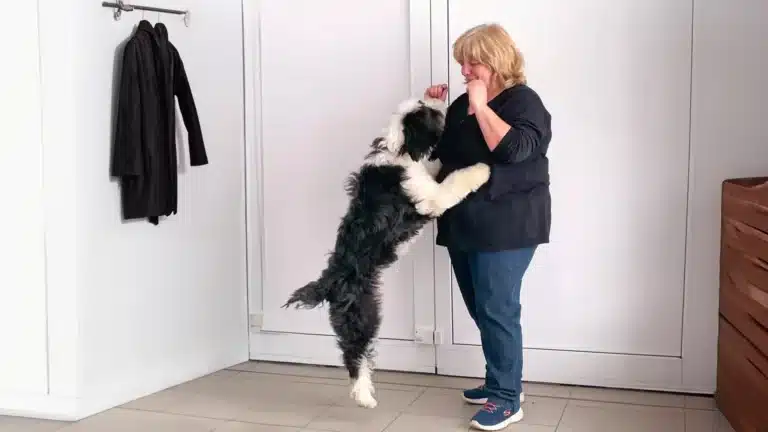
Your dog has learned that jumping on your family is taboo. Still, strangers don't count as family, so they're not safe.
Tips for Prevention:
- Prevention Through Walking: A well-rested dog is often a calmer dog. A good walk before the visit can help release excess energy.
- Training Is the Key: Training should be consistent and regular. The commands "sit" and "stay" are especially helpful. Once your dog has mastered these commands, you can ask him to sit before he has a chance to jump on someone.
- Prepare for the Visit: Inform your visitor of the situation in advance. Ask him to ignore the dog when he arrives and not to look at, talk to, or touch the dog until he has calmed down.
- Use Distraction: A chew bone or toy can help the dog focus on something else when guests arrive.
- Greet Him Calmly: Try to greet your dog calmly when you come home. This will set a standard for how you expect him to behave when other people arrive.
- Professional Help: If barking is a persistent problem, it may be a good idea to contact a professional dog trainer or dog school. They can offer special techniques and exercises tailored to the dog.
It is important to be consistent and not allow the dog to jump on people sometimes and not sometimes. If he understands that jumping is never accepted, he will be more likely to stop.
Try to get other people involved in the training. Relatives, acquaintances, colleagues, and friends are good.
1) Engage Your Visitors
For example, if your dog also jumps on the visitor at home, you can do the following: In this case, the visitor should turn away and completely ignore your dog. Then call your dog.
Learning how to call over your dog a few more tips on how to get your dog to listen to you or respond to your command.
2) Ask Strangers To Ignore Your Dog
It is more difficult when it happens to passers-by on the street: Most walkers find it cute when a puppy jumps on their legs.
They often validate and reinforce his behavior: "Oh, you're so cute." They even encourage jumping.
There is no malicious intent. But it does make training more difficult because the dog experiences a reward from this response.
Ask them to ignore your dog. Explain that you are trying to break your puppy's habit of jumping. When your puppy keeps his paws on the ground, reward him with attention, affection, and a treat.
If an older dog has a tendency to jump on strangers, keep him on a leash during the training period when a passerby is crossing the street.
Try to get your dog's attention through eye contact, touch, petting, or treats.
This will teach him that it's much more interesting and fun to be with you, and over time he'll learn to follow your lead, even when strangers show up.
Guides and Tips
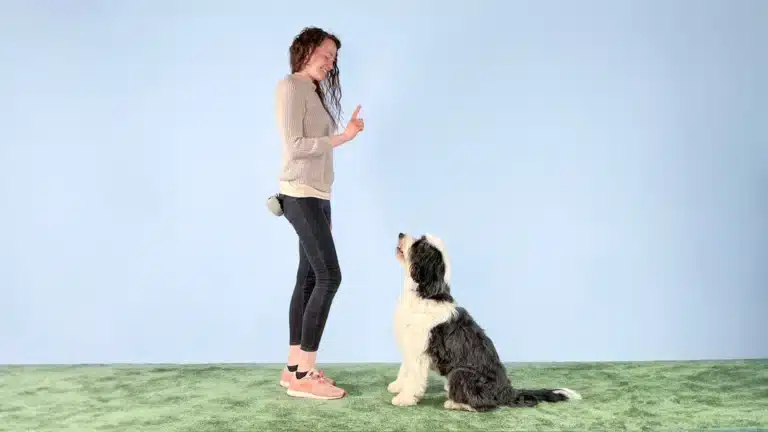
Stay Consistent
If you want to break your dog's jumping habit, everyone in the family should pull together. You should all be using the same tactics. If you are consistent, it is only a matter of time before your puppy or adult dog changes his behavior.
Stay Calm and Relaxed
When you get home, try to be calm and relaxed yourself. The calmer you are, the more likely your dog will follow your lead.
Positive Reinforcement
Praise your dog for staying calm. A treat or a gentle pat when he's not so upset will show him he's on the right track.
Practice, Practice, Practice
With the Hundeo app, you will find fun exercises to turn the greeting ritual into a calm and joyful moment. Training is a game to be enjoyed together!
Search Support
If the problem persists, you can also contact a professional dog trainer who can help you. But don't forget to always use rewards.
Too theoretical for you? If you prefer a visual approach, our app offers step-by-step video instructions to help you break your dog's jumping habit. Learn more about our app here.
Frequently Asked Questions
There are many reasons for this. He may see it as a welcoming ritual - testing his limits with you - it may also be a sign of nervousness or being overwhelmed. More on this in the article above.
A good way to do this is to not react to the jump and turn your body to the side at that moment. You can also counter with a command like "sit" and then reward him with a treat. For more tips, see the article above.
Here you should ask strangers to ignore your dog. Often people will encourage our dogs to jump by looking at or reacting to your dog. It is best to involve other people in your training so that your dog can practice with them to break the habit of jumping.
Conclusion
In the world of our four-legged friends, jumping is more than just jumping. It is an instinct, a silent communication, a sign of joy and sometimes a call for attention.
Understanding this behavior also reminds us of our responsibility to guide our dogs with love and a balance of enthusiasm and respect.
While most of the time our beloved pets mean well when they jump up on us and just want to say hello or play, this behavior can have negative consequences for some people, especially children and the elderly.
With a little patience and love, these stormy greetings can be transformed into harmonious and joyful moments. Have fun training together!
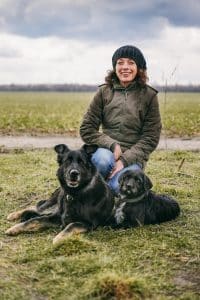
My name is Anja Boecker, and I am a certified dog trainer and behavior consultant. With these articles, I want to help you to understand your dog better and to build an inseparable bond.
Share Now:

